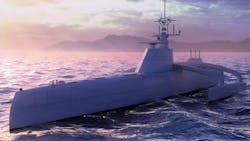Marine Corps to capitalize on Navy's future Large Unmanned Surface Vessel for resupply and troop transport
WASHINGTON – U.S. Marine Corps leaders plan to capitalize on a U.S. Navy plan to develop a Large Unmanned Surface Vessel (LUSV) for long-range resupply missions, and troop transport for Marine Corps warfighters.
That's the word from Marine Corps. Lt. Gen. Eric Smith, commander of the Marine Corps Combat Development Command at Quantico Marine Base, Va. Smith made his comments today at the Association for Unmanned Vehicle Systems International (AUVSI) Defense, Protection, and Security conference in Washington.
The future Navy LUSV could rendezvous with Navy amphibious assault ships offshore to move Marines and supplies quickly where needed, at perhaps lower costs and less risk to human ship crews than is possible today, Smith told AUVSI attendees in a keynote address.
Unmanned systems "are less expensive than people," Smith pointed out in his address. The future LUSV also could augment Navy and Marine Corps reconnaissance and surveillance in contested areas by launching and recovering unmanned aerial vehicles (UAVs) with on-board sensor payloads, Smith said.
Earlier this year Navy leaders requested $400 million from Congress for two LUSVs in the 2020 proposed defense budget, with eight more to be purchased over the next five years.
The Large Unmanned Surface Vessel isn't yet an officials Navy program of record, but is developing under supervision of the U.S. Department of Defense (DOD) Strategic Capabilities Office.
A 2017 DOD program called Project Overlord reportedly is giving rise to the LUSV. Project Overlord seeks take existing autonomy technologies and integrate them into large- and medium-size unmanned surface vessels.
These unmanned marine vessels are expected to carry as much as 40 tons of personnel and cargo, and operate in 8-to-13-foot waves for as long as 90 days without a human crew.
The LUSV would use technology developed under the Sea Hunter project of the U.S. Defense Advanced Research Projects Agency (DARPA) and the Office of Naval Research in Arlington, Va. Earlier this year Navy officials announced that the Sea Hunter navigated autonomously from the U.S. West Coast to Hawaii and back.
The Overlord program will develop core autonomy, communications, command and control, and prototype autonomous vessels, with built-in hardware and software.
In addition to the Marine Corps desired cargo, transport, and surveillance missions, the future LUSV also might be able to carry payloads for electronic warfare, anti-surface warfare, and land-strike warfare.
The first phase of LUSV development involves a prototype unmanned ship with a range of 4,500 miles amid waves as high as 13 feet, with 80,000 pounds payload capacity, and the ability to generate as much as power as 75 kilowatts of 450-volt, 60 Hz, three-phase power for on-board electronic payloads.
At this early stage, Navy experts envision a LUSV about 200 to 300 feet long, about a third the size of a future Navy frigate.
About the Author
John Keller
Editor-in-Chief
John Keller is the Editor-in-Chief, Military & Aerospace Electronics Magazine--provides extensive coverage and analysis of enabling electronics and optoelectronic technologies in military, space and commercial aviation applications. John has been a member of the Military & Aerospace Electronics staff since 1989 and chief editor since 1995.
